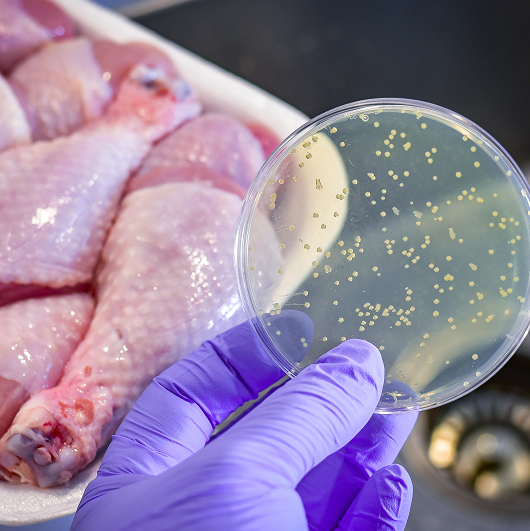Food Safety Tips Every Host Should Know

April 15, 2025
Picture this: you've spent hours preparing a delicious meal for your guests, only to have the celebration derailed by food poisoning. It's a host's worst nightmare, but one that's easily preventable.
This guide provides essential food safety tips to ensure the success of your next gathering, keeping your guests healthy and happy from appetizers to desserts.
Food Prep Best Practices
Prepping food for a party or a crowd can be full of opportunities for harmful bacteria like salmonella and viruses like norovirus (the stomach bug) to contaminate food or the surfaces you serve food on. The good news is that you can prevent these bugs from reaching your plate with simple steps.
Keep Yourself and Your Station Clean
Wash your hands with soap and water before and after food prep to ensure you remove any bacteria or viruses that might transfer to food. Likewise, anything hanging out on your food won’t hitch a ride on your hands before landing on other surfaces in your kitchen.
Clean cutting boards, surfaces and utensils between uses with hot, soapy water.
Separate Foods
Separate raw meats, poultry and seafood in your shopping cart and the refrigerator to prevent their juices from dripping on other foods—especially those that will be eaten raw.
If possible, use separate cutting boards: one for fruits and vegetables and one for raw meats. Always use clean platters and utensils for serving. If a dish had raw food, wash it before reusing it.
Cook Foods to the Right Temperature
Heating foods to the right temperature for the proper amount of time kills harmful bacteria, so cook meat, poultry, fish and eggs thoroughly. Use a food thermometer to be sure, and use this list to find the safe internal temperature for each food.
If you use the juices from cooked meats to make sauces or gravy, bring it to a boil before serving.
Keep Food Cold Until It’s Time to Eat
Making food in advance can save you stress, but only if you follow safe storage rules. Refrigerate all perishables (foods that can spoil or become contaminated with bacteria if not refrigerated) until party time.
These foods include:
- Finger sandwiches
- Cheese chunks
- Soufflés
- Fruit salad
- Dips
- Foods that contain dairy products
How to Serve Food Safely
Cooked food still carries a risk of foodborne illness. Follow these guidelines to keep food at the proper temperature and limit the spread of bacteria among your guests.
Keep Cold Foods Chilled and Hot Foods Warm
Keep cold foods at 40℉ or colder. If you plan to serve food for longer than two hours, place plates of cold food on ice to retain the chill.
To keep bacteria at bay, keep hot foods at an internal temperature of 140℉ or warmer; use a food thermometer to check. Keep food hot in chafing dishes, slow cookers and warming trays. Be aware that some warmers only hold food at 110℉ to 120℉, so check the product label to ensure your warmer can keep foods at 140℉ or warmer.
Eggs and egg dishes, such as quiches or soufflés, should be thoroughly reheated to 165℉ before serving if they were refrigerated after cooking.
Serve Food in Small Amounts and Use Fresh Serveware
If you’re planning a buffet, keep portions small. Prepare multiple servings beforehand, so you can quickly replenish dishes that run low.
During a party, bacteria from people’s hands can contaminate the food, so replace the serving dish each time you put out more food. Store cold backup dishes in the refrigerator, or keep hot backup dishes in the oven set at 200℉ to 250℉.
Don’t Keep Food at Room Temperature for Too Long
Remember the two-hour rule: Discard any perishables left out at room temperature for longer than two hours unless you keep it hot or cold.
If your buffet's room temperature is above 90℉, food can only be kept out for one hour unless it’s kept appropriately hot or cold. The same rules apply to leftovers. Whether sending food home with guests or saving it for yourself, refrigerate it as soon as possible or within two hours.
How to Adapt Family Recipes Safely
Some of your favorite traditional recipes may call for raw or lightly cooked eggs. Foods on this list may include:
- Homemade Caesar salad dressing
- Ice cream
- Custards
- Rice pudding
- Chocolate mousse
- Eggnog
- Some sauces
Some raw eggs contain harmful bacteria, which can be particularly dangerous when consumed by people at heightened risk for foodborne illness, such as pregnant women, young children, seniors and those with a compromised immune system.
Help keep your guests safe by adapting your favorite egg-containing recipes (or substituting prepared products for some items). A few methods you can try include:
- Combining the called-for eggs and liquid in a recipe, then heating the mixture until it reaches 160℉ on a food thermometer
- Using store-bought versions of the foods listed above, which are often already cooked or pasteurized. (Check the label to be sure.)
- Using pasteurized eggs. Find these in some supermarkets with the label “pasteurized.” You can purchase pasteurized eggs fresh, frozen, powdered or in liquid form.
Next Steps & Resources:
- Meet Our Source: The oncology dieticians at John Theurer Cancer Center
- To make an appointment with a provider near you, call 800-822-8905 or visit our website.
The material provided through HealthU is intended to be used as general information only and should not replace the advice of your physician. Always consult your physician for individual care.






